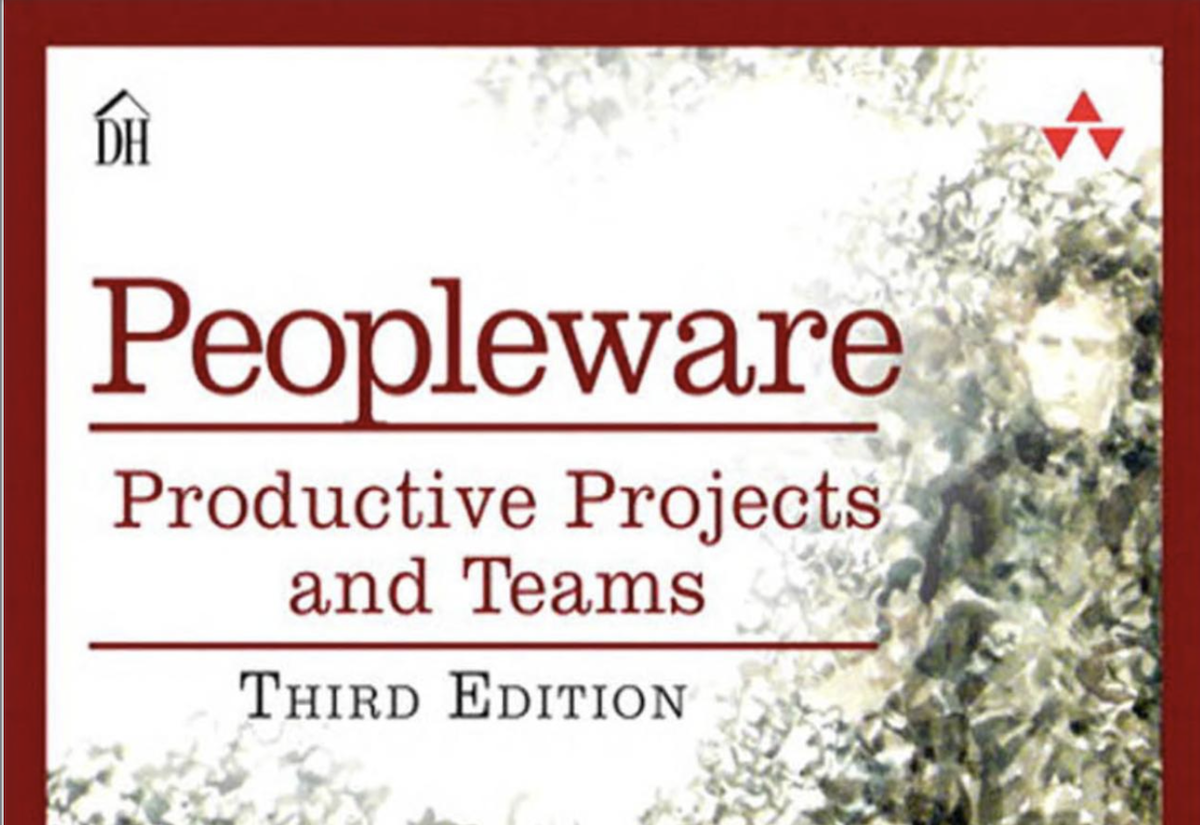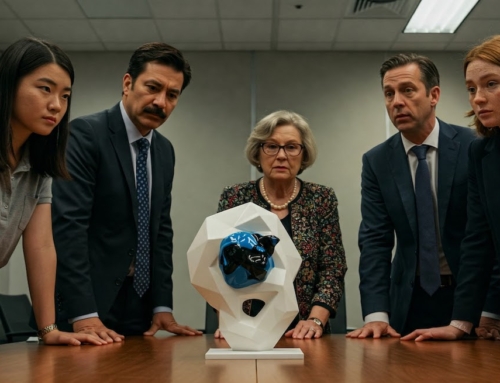
Peopleware: Productive Teams and Projects
“The major problems of systems work [software development] are not so much technological as sociological”
First published in 1987, Tom DeMarco and Timothy Lister were some of the earliest people to think of software development primarily of a human challenge rather than a technical riddle to solve. Reviewing data from over 500 projects, they discovered that for projects that were canceled, failed to deliver or delivered a product that was never used, there was no single technological reason to explain the failure. The often quoted reason for failure was “politics”, but according to DeMarco and Lister a more accurate description for the cause of project failure would be “project sociology”.
Peopleware is classic in software management written by two well-respected consultants and leaders in the field. With their book, DeMarco and Lister crafted a collection of short essays, i.e. chapters, supporting their argument that in order to have greater success with software development, managers need to understand and manage the project sociology better. Leaders who manage the technical aspects, at the expense of the human interactions, are focused on the wrong factors because they are laboring under, what they call, the High Tech Illusion. The High Tech Illusion is the belief that because the work involves computers and technology, by definition they must be participating in a high-tech business. The reality is that many, many software teams are not creating the fundamental breakthroughs common in a true high-tech business, but are just applying, combining and extending the discoveries of others for a commercial endeavor. The real business of a software manager is human communication.
The book is divided into six parts – Managing the Human Resource, The Office Environment, The Right People, Growing Productive Teams, Fertile Soil and It’s Supposed to Be Fun to Work Here. In my review, I will highlight the first five parts since the bulk of the book is spent in these areas. Even though last section is interesting, it seems more like a supplement rather than a complete section of the book.
Managing the Human Resource
This first part of the book is where the authors lay out their primary premise – software development is a human interaction problem, not a technology problem. In this section, DeMarco and Lister communicate three major concepts.
The first is that software development is not production. To DeMarco and Lister, this “make a cheeseburger, sell a cheeseburger” mentality, is fatal to any software project. The idea that a software project should strive to squeeze out error, come down hard on people for goofing off at work, treat people as interchangeable pieces, standardize procedures and eliminate experimentation is at odds with the nature of the work. A software project is all about discovery, innovation and serendipity. To standardize the processes and people, to stamp out errors and research and extinguish silliness hobbles any new product development effort.
The second idea is the difference between the Spanish vs. English Theories of Management. The Spanish Theory holds that there is a fixed amount of value on the planet and we need to discover ways to extract more and more value from finite resources. The English Theory believes that the amount of value on Earth is not finite and additional value can be created through the application of ingenuity and invention. The problem is that Spanish Theory shows up at work all the time. Think of the last time management created an unrealistic deadline that could only be accomplished through overtime and long hours at work – that’s Spanish Theory in action. If you feel people are not working hard enough unless they are under some type of duress – more Spanish Theory. “People under time-pressure don’t work better – just faster” and that has an impact on quality and customer satisfaction.
Third DeMarco and Lister revisit Parkinson’s Law. Everyone has heard at least once in their career, “work expands to fill the time allotted”, aka Parkinson’s Law. What most people do not realize that Parkinson’s Law is not a law at all, but a witticism crafted in 1954 by a humorist to describe people working in soul-crushing bureaucracy, the British Post Office. What DeMarco and Lister find unsettling is that management types quote Parkinson’s Law all the time with respect to software development not knowing Parkinson’s Law simply does not apply to software development. Why? One, your business is not a soul-crushing bureaucracy. Two, your business is filled with passionate people who want the business to succeed, you just put them in a bad environment. So rather than turning the blame on lazy workers (as Spanish Theory suggests), a more accurate re-statement of Parkinson’s Law would put the blame where it belongs – “organizational busy work expands to fill the working day.”
The Office Environment
This second part of the Peopleware is one of the most important aspects to discuss since how the office is designed has a great impact on individual productivity, or as the authors refer to it, flow. Flow is VERY important for software developers. Their best work is often produced in this state of flow and get extremely frustrated when they cannot achieve their focus. In general, DeMarco and Lister make a good case explaining why noisy offices are bad, how they prevent flow, cause the introduction of errors and why the Furniture Police need to be resisted. They also lay out their vision for the ideal office configuration for knowledge work based on a 1978 research study from IBM. The result – each person needs 100 square feet of space and 30 square feet of work surface.
One of the more interesting stories from this part was an anecdote from a California company looking to improve employee satisfaction. This company surveyed over a 1000 employees asking them what were the best and worst aspects of their jobs. After tabulating the results, management got right to work on their number two problem – improving communication with upper management. When DeMarco asked what was number one obstacle, the client responded “The environment, people were upset over the noise.” Surprised, DeMarco asked what the client did to make things quieter, the client responded, “We couldn’t do anything about that. That is outside our control.”
That is complete and utter horseshit! Managers control things. That is why they are called managers. After a certain point, they only way you can reward a manager is by giving them more and more control. Don’t let managers fool you, they control the environment. The only reason why offices are noisy and do not meet the needs of the people doing the work is because that is the way management wants the environment to be. The office layout is an expression of the office hierarchy and is designed to remind you of your lowly place in the enterprise.
Finally, I found an interesting statistic regarding the use of the ubiquitous headphones one regularly sees in an open floor plan. While headphones are good at reducing background noise (and preventing interruptions), a study of math problems at Cornell demonstrated background music also reduced insights and whole problem thinking. Alas, while Part Two has some great recommendations for the office, it also has some of the most dated chapters in the book – lots of references to ringing telephones and intercom systems.
The Right People
Part Three of the book gives guidance on finding and retaining your talent. The DeMarco and Lister formula for success is based on three simple concepts: get the right people, keep them happy so they do not leave and then “turn them loose” on the problem.
What I found most startling in Part Three of this book were the back-of-the-envelope calculations DeMarco and Lister provided for the cost of turnover. Turnover in a typical organization can range from 33% to 80% a year, meaning the average person lasts about two years in an organization before deciding to move on. So what is the cost of the business? To simply find the person, the business will have to hire an agency or headhunting firm which will cost about two months of that person’s salary. As we all know, once someone is hired, they are not 100% productive on Day One. Normally, it takes about five months for the average person to work at full capacity and longer if the skill you are hiring is rare or context sensitive.
So why do businesses accept these costs? According to DeMarco and Lister, the main cause for such high turnover is the short-term mentality associated with the Spanish Theory of Management. When a Spanish Theory manager is presented the opportunity to make sensible investments in the product quality, office environment, skill development and\or cultural change, what they tell you is this, “We’re too busy” or “It costs too much for right now”. What their actions say is this, “I’m too busy making sure my exit looks good to worry about you suckers that are left behind.”
Finally, a few important words on the hiring process. According to Peopleware, too much time is spent on hiring based on appearances and too little time is spent evaluating the capabilities of the candidate. The process is designed to find “normal” people who are a “good fit”, but in the end these normal people simply reinforce your own biases, the biases of your boss, the biases of the people already employed by the business and the organizational norms. People who find “chickens with lips” funny are not going to be hired. The solution proposed by DeMarco and Lister is simple: ask people to bring a portfolio of representative work and ask them to audition for the job.
So what is an audition? The Extreme Programming (XP) world has an answer. Ask job candidates to pair with different members of the Team on solving day-to-day technical problems. I can personally vouch for the effectiveness of pairing during the interview process. You learn so much about a candidate during pairing that cannot be captured in a traditional interview. Pairing accurately evaluates people based on their capabilities and weeds out the people who look good on paper, but can’t actually do the work. The only catch is that paired interviews take more time.
Growing Productive Teams
Part Four of the book is focused on how to develop and grow high-performing teams. When a team has achieved this state of high-performance, when they have a sense of momentum, DeMarco and Lister would say they have “jelled”
So how do we know if a team has jelled? We know a team has jelled when we review their results. For the most part, the results are astonishing in their depth and quality. A team that has jelled has extremely low turnover, a strong identity, a sense of eliteness, joint ownership of the work and naturally enjoys working with one another. A jelled team works as a network of peers, they coach and teach one another. Leadership roves among the team members based on their knowledge, skills, aptitude and the challenge before them. The overriding goal of a high-performing team is to become nothing less than the absolute best. The best managers are not threatened by a jelled team and act in ways consistent with Servant Leadership. Servant Leaders do whatever they can to help the team feel special and appreciated by the organization. Instead of walking around like prison guards watching over the inmates, managers ask, “How can I help you?”
Regrettably, there is no cookbook of steps to follow that will make a team jell in every circumstance. So much is dependent on context, the organizational culture, the members of the team and the degree of autonomy they have. However, when business operates from a space of defensive management – the complete lack of trust in your own staff to do the right thing – they ruin all chance for self-organization and kill all hope of forming a jelled team. The term for all the actions and decisions made by businesses that kills well-functioning teams is called teamicide.
Fertile Soil
In the fifth section of their book, DeMarco and Lister discuss what type of culture best supports healthy work and avoids wasting people’s time (which they consider the ultimate management sin). When managers spend most of their day responding to email and coordinating the activities of staff, they are not doing two things. One, they are not teaching staff members how to self-coordinate their own actions and are building a culture of dependency. Two, they are not spending time managing the project and dealing with risk.
Since our industry is constantly in search of the next silver bullet, it is no surprise that many organizations gravitate toward a Methodology as the answer for dealing with all the uncertainty associated with new product development. If the work can be made more deterministic, i.e. we have a policy and procedure for every conceivable situation regardless of the skill of the person competing the task, then we can achieve standardization, consistently between teams and predictability. But behind every Methodology (or Process) is the inherent assumption that the people who define the Process are smart and the people who implement it are dumb (or simply suckers for following it).
Of course, DeMarco and Lister have something to say about one of the biggest waste of time in business today – the meeting. In their experience, meetings that are productive and useful generally are ad hoc, called to reach a decision, conversational in nature and have the minimum number of participants necessary to reach consensus on the decision. So why do meetings get bogged down? When meetings become ceremonies to get noticed climbing up the corporate ladder.
One final comment regarding meetings and the use of laptop computers during a meeting. First, the technology has not enhanced the meeting one bit and contributes to the dreadfulness of meetings. Two, once the laptops are out it is a clear sign that people feel the meeting is pointless. If you are bored by a meeting or see the whole conversation pointless, just leave. What goes on at meetings is so shocking, but it bears to repeat the authors’s words, meeting “behavior that we take for granted today would have gotten you fired a generation ago.”





